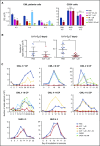Targeting chronic myeloid leukemia stem cells with the hypoxia-inducible factor inhibitor acriflavine
- PMID: 28576876
- PMCID: PMC5942867
- DOI: 10.1182/blood-2016-10-745588
Targeting chronic myeloid leukemia stem cells with the hypoxia-inducible factor inhibitor acriflavine
Abstract
Chronic myeloid leukemia (CML) is a hematopoietic stem cell (HSC)-driven neoplasia characterized by expression of the constitutively active tyrosine kinase BCR/Abl. CML therapy based on tyrosine kinase inhibitors (TKIs) is highly effective in inducing remission but not in targeting leukemia stem cells (LSCs), which sustain minimal residual disease and are responsible for CML relapse following discontinuation of treatment. The identification of molecules capable of targeting LSCs appears therefore of primary importance to aim at CML eradication. LSCs home in bone marrow areas at low oxygen tension, where HSCs are physiologically hosted. This study addresses the effects of pharmacological inhibition of hypoxia-inducible factor-1 (HIF-1), a critical regulator of LSC survival, on the maintenance of CML stem cell potential. We found that the HIF-1 inhibitor acriflavine (ACF) decreased survival and growth of CML cells. These effects were paralleled by decreased expression of c-Myc and stemness-related genes. Using different in vitro stem cell assays, we showed that ACF, but not TKIs, targets the stem cell potential of CML cells, including primary cells explanted from 12 CML patients. Moreover, in a murine CML model, ACF decreased leukemia development and reduced LSC maintenance. Importantly, ACF exhibited significantly less-severe effects on non-CML hematopoietic cells in vitro and in vivo. Thus, we propose ACF, a US Food and Drug Administration (FDA)-approved drug for nononcological use in humans, as a novel therapeutic approach to prevent CML relapse and, in combination with TKIs, enhance induction of remission.
© 2017 by The American Society of Hematology.
Conflict of interest statement
Conflict-of-interest disclosure: The authors declare no competing financial interests.
Figures







Similar articles
-
Physiologic hypoxia promotes maintenance of CML stem cells despite effective BCR-ABL1 inhibition.Blood. 2014 May 22;123(21):3316-26. doi: 10.1182/blood-2013-07-511907. Epub 2014 Apr 4. Blood. 2014. PMID: 24705490
-
Repurposing of Acriflavine to Target Chronic Myeloid Leukemia Treatment.Curr Med Chem. 2021;28(11):2218-2233. doi: 10.2174/0929867327666200908114411. Curr Med Chem. 2021. PMID: 32900342 Review.
-
CD150(-) Side Population Defines Leukemia Stem Cells in a BALB/c Mouse Model of CML and Is Depleted by Genetic Loss of SIRT1.Stem Cells. 2015 Dec;33(12):3437-51. doi: 10.1002/stem.2218. Epub 2015 Oct 15. Stem Cells. 2015. PMID: 26466808 Free PMC article.
-
Targeting protein lysine methyltransferase G9A impairs self-renewal of chronic myelogenous leukemia stem cells via upregulation of SOX6.Oncogene. 2021 May;40(20):3564-3577. doi: 10.1038/s41388-021-01799-1. Epub 2021 Apr 30. Oncogene. 2021. PMID: 33931742
-
Molecular mechanisms for survival regulation of chronic myeloid leukemia stem cells.Protein Cell. 2013 Mar;4(3):186-96. doi: 10.1007/s13238-013-2115-0. Epub 2013 Mar 13. Protein Cell. 2013. PMID: 23483480 Free PMC article. Review.
Cited by
-
Macrophage metabolic reprogramming aggravates aortic dissection through the HIF1α-ADAM17 pathway✰.EBioMedicine. 2019 Nov;49:291-304. doi: 10.1016/j.ebiom.2019.09.041. Epub 2019 Oct 19. EBioMedicine. 2019. PMID: 31640947 Free PMC article.
-
Inhibition of the H3K9 methyltransferase G9A attenuates oncogenicity and activates the hypoxia signaling pathway.PLoS One. 2017 Nov 16;12(11):e0188051. doi: 10.1371/journal.pone.0188051. eCollection 2017. PLoS One. 2017. PMID: 29145444 Free PMC article.
-
HIF1α inhibition facilitates Leflunomide-AHR-CRP signaling to attenuate bone erosion in CRP-aberrant rheumatoid arthritis.Nat Commun. 2019 Oct 8;10(1):4579. doi: 10.1038/s41467-019-12163-z. Nat Commun. 2019. PMID: 31594926 Free PMC article.
-
Targeting the Extracellular Signal-Regulated Kinase 5 Pathway to Suppress Human Chronic Myeloid Leukemia Stem Cells.Stem Cell Reports. 2018 Oct 9;11(4):929-943. doi: 10.1016/j.stemcr.2018.08.016. Epub 2018 Sep 20. Stem Cell Reports. 2018. PMID: 30245209 Free PMC article.
-
Targeting HIF-1α by Natural and Synthetic Compounds: A Promising Approach for Anti-Cancer Therapeutics Development.Molecules. 2022 Aug 15;27(16):5192. doi: 10.3390/molecules27165192. Molecules. 2022. PMID: 36014432 Free PMC article. Review.
References
-
- Druker BJ, Sawyers CL, Kantarjian H, et al. . Activity of a specific inhibitor of the BCR-ABL tyrosine kinase in the blast crisis of chronic myeloid leukemia and acute lymphoblastic leukemia with the Philadelphia chromosome. N Engl J Med. 2001;344(14):1038-1042. - PubMed
-
- Graham SM, Jørgensen HG, Allan E, et al. . Primitive, quiescent, Philadelphia-positive stem cells from patients with chronic myeloid leukemia are insensitive to STI571 in vitro. Blood. 2002;99(1):319-325. - PubMed
-
- Giuntoli S, Rovida E, Barbetti V, Cipolleschi MG, Olivotto M, Dello Sbarba P. Hypoxia suppresses BCR/Abl and selects imatinib-insensitive progenitors within clonal CML populations. Leukemia. 2006;20(7):1291-1293. - PubMed
Publication types
MeSH terms
Substances
Grants and funding
LinkOut - more resources
Full Text Sources
Other Literature Sources
Medical
Molecular Biology Databases
Miscellaneous

